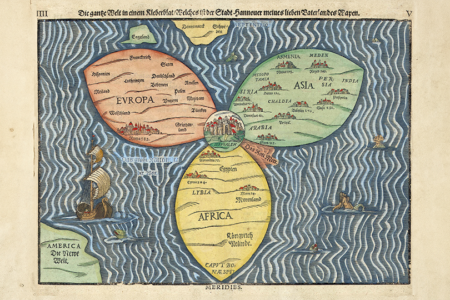The Signal Event of the Day of the Lord
To what Jewish temples do the words destruction and desolation apply? Are we in the Day of the Lord today? The answers lie in 2 Thessalonians 2:1–5.
When will the Day of the Lord occur? Are we in it now? Could it be fast approaching? How are believers to know? These were the concerns the apostle Paul addressed in his second letter to the church at Thessalonica.
The problems of that day, like those of today, were fueled by the sensational claims of various prophecy teachers who caused the Thessalonian believers in Christ to fear they had already entered the terrible time of God’s wrath called the Tribulation (2 Th. 2:1–2) and, therefore, had missed the deliverance promised through the Rapture of the church (1 Th. 1:10; 5:9).
Paul previously had explained how the Day of the Lord will come suddenly on a deceived world unaware of the predicted judgment (5:1–3; cf. Lk. 17:26–30; 2 Pet. 3:3–9) but will not overtake believers, for they are not destined for that time of wrath (1 Th. 5:4, 9).
Unfortunately, believers can become confused and thereby distressed concerning the Word of Truth when they listen uncritically to unsound spokesmen. Too many Christians today are unsure there will even be a Rapture (when all who have trusted Christ, living and dead, will be caught up in an instant to meet the Lord in the air). So, it is necessary to understand the clear, encouraging message of Scripture concerning the timing of the Day of the Lord and the signal event that reveals it.
The DOL in 2 Thessalonians
The use of the term Day of the Lord (DOL) by Paul and other New Testament writers was based on their understanding of how the Old Testament prophets used it. In the Old Testament, the Day of the Lord is a concept both simple and complex.
Simply speaking, it is any divine intervention at any time in history. Most cases involve divine judgment of Israel (whether to discipline or deliver). Theologically, these DOLs are in contrast to the DOL, that climactic future event to which they point in God’s program with Israel and the nations.
Complicating the identification of a DOL is the multiplicity of terms used to describe it in the Old Testament and its focus on the Tribulation.1 Therefore, New Testament writers applied the phrase to both the judgment terminating the Tribulation (1 Th. 5:2), also known as Daniel’s 70th week (see “What Is the 70th Week of Daniel?”), as well as the one ending the present world with the creation of the new heavens and earth (2 Pet. 3:10).
In 2 Thessalonians 2:2–12, Paul discussed the Tribulation-related DOL. The Thessalonians worried that their persecution at the hands of the Roman Empire had inaugurated that awful time of God’s judgment. But Paul explained that a failure to distinguish the proper timing of Daniel’s 70th week prophecy leads to confusion and to incorrectly placing the events predicted for national Israel and those predicted for the Church Age into a single event within the Tribulation.
This erroneous teaching, which the Thessalonian believers received, has its modern counterpart in Preterism, Posttribulationalism, and the Pre-Wrath Rapture view. Preterism teaches the events predicted in the DOL already have occurred. Posttribulationalism and the Pre-Wrath Rapture view maintain that the church will, to some extent, experience the DOL.
Paul’s overriding concern was that the Thessalonians’ misunderstanding of the Day of the Lord affected their hope of the Rapture,2 about which he had labored to teach them (1 Th. 4:13–18).
Paul held the believers’ assurance of this “blessed hope” (Ti. 2:13) as an important truth meant to both comfort and encourage (1 Th. 4:18; 5:9–11), as well as galvanize (5:6–8; cf. Rom. 13:11–14; Ti. 2:11–14) them to witness to their faith in Christ in the midst of persecution (Col. 1:24; cf. 1 Pet. 4:7–19). He therefore opened his appeal to the church in 2 Thessalonians 2:1 “concerning” (v. 1) the Rapture, since it preceded the DOL and was essential to its timing with respect to the Tribulation.
The Tribulation’s Signal Event
As Paul began his explanation, he observed that the entire Tribulation is a period of religious “apostasy”3 (2 Th. 2:3). The Day of the Lord—the time of God’s terrestrial judgment on the unbelieving world (“those who dwell on the earth,” Rev. 6:10; cf. 8:13; 11:10; 13:8; 17:2, 8)—follows (comes in response to) the advent of this specific global defection from truth (“the apostasy”) to embrace the Antichrist system (cf. Lk. 18:8; Rev. 13).
While we may see global preparations for this apostasy today, it has not arrived. That which is necessary for it to take place and be clearly revealed to those in the Tribulation does not yet exist, namely the Antichrist4 and his program of hostility to the things of God, climaxed by his usurping the place of divinity within a rebuilt Temple in Jerusalem:
Let no one deceive you by any means; for that Day will not come unless the falling away comes first, and the man of sin is revealed, the son of perdition, who opposes and exalts himself above all that is called God or that is worshiped, so that he sits as God in the temple of God, showing himself that he is God (2 Th. 2:3–4, emphasis added).
The Antichrist’s desire to be exalted above every divine being reveals that Satan is one with this human (a counterfeit incarnation), as Satan’s desire is to be “like the Most High” (Isa. 14:14).
If the signal event is the Antichrist establishing himself in the Temple, both in making and breaking a covenant with Israel (Dan. 9:27), then we must discern which Temple the apostle had in view.
In the Olivet Discourse, the Lord Jesus predicted the Temple would be destroyed and desecrated (Mt. 24:15; Mk. 13:14) before He comes to judge Israel’s enemies (on the DOL). Christ told His disciples, “Do you not see all these things [Temple buildings]? . . . Not one stone shall be left here upon another, that shall not be thrown down” (Mt. 24:2).
His statement elicited questions: “When will these things be? And what will be the sign of Your coming, and of the end of the age?” (v. 3). The Gospels of Matthew and Mark address the last two of these questions (the answer is Daniel’s 70th week), and the Gospel of Luke only addresses the imminent prediction of destruction.
Even though both were DOL events, the end-times event was separate from the imminent event because its signal event of desecration was not imminent but, rather, tied to Daniel’s 70th week (Mt. 24:15; Mk. 13:14) and the Second Coming. When Paul explained the end-times sign event to the Thessalonians, the second Temple’s imminent destruction by the Romans (Lk. 21:20–24) had not yet occurred. The desecration is part of “the falling away” (2 Th. 2:3) that brings the revelation of the Antichrist apostasy (v. 4) and “the lie” (v. 11) that he is God.
For the Temple to be desecrated after it is destroyed implies a future rebuilding for the desecration prophecy to take place. Both Matthew 24:15 and Revelation 11:1–2 follow the timetable of Daniel’s 70th week prophecy, which first speaks of the Temple’s destruction (Dan. 9:26) and then of a future desecration (v. 27).
Luke 21:24 understands this same timetable as it refers to the “times of the Gentiles,” the period of Israel’s national discipline that will end with the Lord’s return to destroy Israel’s enemies (Zech. 12:2–9; 14:2–15; Rev. 19:11–21):
For there will be great distress in the land and wrath upon this people. And they will fall by the edge of the sword, and be led away captive into all nations. And Jerusalem will be trampled by Gentiles until the times of the Gentiles are fulfilled (Lk. 21:23–24).
Luke saw the Temple’s destruction as national ruin and a sign of God’s vengeance and wrath on national Israel (vv. 22–23) for violating the Mosaic Covenant (Lev. 26:14–15, 25, 33) that required the nation accept its Messiah (Dt. 18:15–19).
The Need for Discernment
Following this reasoning, Paul told the Thessalonians the Day of the Lord cannot be discerned until the time of Daniel’s 70th week, when a (rebuilt) Temple could be part of a covenant leading to its desecration by the Antichrist.
This needed discernment may be one reason for the parenthetical statement let the reader understand in Jesus’ statement regarding Daniel’s prophecy: “‘So when you see the “abomination of desolation,” spoken of by Daniel the prophet, standing where it ought not’ (let the reader understand), ‘then let those who are in Judea flee to the mountains’” (Mk. 13:14; cf. Mt. 24:15–16).
Paul’s similar appeal to “understanding” is implied in his concern for the Thessalonian believers and the deceptive influences they faced (2 Th. 2:3), despite them having been taught the truth (v. 5).
Today, we see Orthodox Jews in Israel preparing to rebuild the Temple. They have blueprints, ritual vessels, and the red heifer (Num. 19:2). We see the push for globalization and the desire for a competent leader who can unite the world. We see the call for governmental regulation over individual identities so that even what people buy or sell is controlled.
And we see Christianity facing serious decline as the pressure to conform to a pagan society increases.5 Nevertheless, as this passage instructs, we are not in the Day of the Lord; and no believer in the Church Age will enter it because the Rapture will deliver us from this Tribulation. However, as we see the outline of this future DOL in our day, let us be certain of our faith in Christ alone and await with confidence our Blessed Hope.
ENDNOTES
-
-
- For a study of some of the terms used in this article, see Randall Price, “Old Testament Tribulation Terms” in Thomas Ice and Timothy Demy, eds., When the Trumpet Sounds (Eugene, OR: Harvest House, 1995), 57–83.
- Both nouns “coming” (parousia) and “assembling, gathering together” (episunagoges) in verse 1 are governed by one article, indicating they are the same event. For more details see Mike Stallard, First and Second Thessalonians: Looking for Christ’s Return, Twenty-First Century Biblical Commentary Series, eds. Mal Couch and Ed Hindson (AMG Publishers, 2009), 166–67.
- For an understanding of this term as spiritual apostasy, see Lee W. Brainard, Apostasia in 2 Thessalonians 2:3 (Self-published, 2021) and Seth Knorr, The Apostasia—Rapture or Rebellion (Self-published, 2021). For the view that the term refers to a physical “departure” and thus the Rapture, see Dr. Andy Woods, The Falling Away (n.p., Dispensational Publishing House, 2018) and H. Wayne House, “Apostasia in 2 Thessalonians 2:3: Apostasy or Rapture?” in Thomas Ice and Timothy Demy, eds., When the Trumpet Sounds (Eugene, OR: Harvest House, 1995), 261–69.
- See Ron Rhodes, Unmasking the Antichrist (Eugene, OR: Harvest House, 2012).
- On this decline see John Daniel Davidson, Pagan America (Washington, DC: Regnery/Skyhorse, 2024), 73–125.
Photo: Adobe Stock
-







